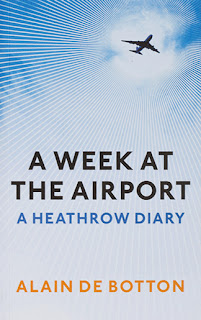 I don’t mind flying, but I love airports.
I don’t mind flying, but I love airports.Getting up at half four in the morning to catch the red-eye to a London airport isn’t the best start to a day. But I love thinking about the complexity of airports, with so many different organisations working alongside – sometimes in spite of each other – to create a transport hub with its enormous car parks and baggage handling and the associated shopping malls with beefed-up security.
Given the number of times I’d travelled through Belfast City Airport, touring around behind the scenes a couple of years ago was great fun. Several times I’ve ended up staying in Gatwick’s Sofitel hotel for two or three nights at a time. It’s directly connected to the North Terminal, so I’d get back from work on the train in the late evening, catch the monorail over from the South Terminal before mooching through the terminal towards bed.
So I read Alain de Botton’s A Week at the Airport: A Heathrow Diary
Had one been asked to take a Martian to visit a single place that nearly captures the gamut of theme running through out civilisation – from our faith in technology to our destruction of nature, from our interconnectedness to our romanticising of travel – then it would have to be to the departures and arrivals halls that one would hear.
The airport’s owners gave him a bedroom in an terminal-connected hotel, meal vouchers for airport restaurants, a pass to move around from departures through to airside and back to arrivals, and a desk in the departure hall between zones D and E. In return, along with photographer Richard Baker, Alain de Botton talked to staff and passengers, visited the on-site catering ‘factory’, sat on the closed runway in the middle of the night, and discovered that the terminal’s largest bookshop didn’t stock any of his titles.
Having evaluating the unusual no-strings job offer, Alain de Botton decided to accept:
I felt it would be churlish of me to decline to investigate my caller’s offer simply because his company administered airside food courts and hosted technologies likely to be involved I raising the planet’s median air temperature.
His sharp-eyed observations were translated into well-crafted phrases:
A passenger walkway rolled forward and closed its rubber mouth in a hesitant kiss over the front left-hand door.
As an all-seeing voyeur his eye and pen lingered over lovers saying goodbye, commentating like a judge from Strictly Come Dancing on the sense of passion and the moment of separation, before splitting up with photographer Richard so they could follow one party airside and the other back to the train to gauge their emotional reaction, all from a distance.
The security staff “look at every human being as through he or she might want to blow up an aircraft – a thoroughgoing reversal of our more customary impulse to find common ground with new acquaintances”. The need to stay alert earns these workers “more frequent tea breaks than other employees”.
Going airside he got to grips with why people often complain about airport consumerism:
… an incongruity between shopping and flying, connected in some sense to the desire to maintain dignity in the face of death.
Despite the many achievements of aeronautical engineers over the last few decades, the period before boarding an aircraft is still statistically more likely to be a prelude to a catastrophe than a quiet day in front of the television at home. It therefore tends to raise questions about how we might best spend the last moments before our disintegration, in what frame of mine we might wish to fall back down to earth – and the extent to which we would like to meet eternity surrounded by an array of duty-free bags.
Alain de Botton avoided becoming overly romantic about his stay in the airport … although he did see a future for himself as a writer-in-residence on board BA jets! Instead the 107 page book gently shone a light on the terminal, slowing time down to give readers a chance to look around instead of rushing through with their bags to get to the gate. Yet passengers ended up with fewer pages than the staff and characters who kept the airport running (including the shoe-shiner who I recognise from my days going through Terminal 1).
I doubt you’ll experience a travel epiphany while reading A Week at the Airport, but it might brighten up a delayed flight, and Richard Baker’s photographs add greatly to the prose. Available at all good airport bookshops, on Kindle as well as lots of second-hand copies on Amazon.
Thanks to Mr Ulster for mentioning [and I've now noticed, reviewing] the book. Good tip.
No comments:
Post a Comment